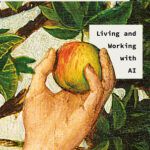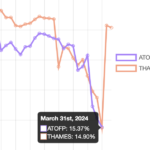In a world of information, the way we measure combinations of words or ideas is important. Some people say it might even save humanity. Last year, economists Eric Brynolfsson and Andrew McAfee suggested that increasing combinations of business ideas could save us from being supplanted by intelligent machines.
Like any powerful algorithm, combinatorics is both hopeful and terrifying. It’s behind the ennui one feels in supermarkets when you are confronted with increasing choices and have to make a selection of them. It’s the fundamental fact behind writer’s block: when there are so many ways of shuffling words, where do you start?
To see how scary it can be, read the Library of Babel by Jorge Luis Borges, one of my favourite short stories. Its power comes from the way it deploys what mathematicians call the combinatoric explosion as a horror story. 
It doesn’t feel like a normal story. There is a narrator but no other characters to speak of, yet the story builds up with an increasing sense of dread in the reader. Trapped in a vast library, most of which is gibberish, the inhabitants try to make sense of it. They form religious sects and schisms, squabbling over the meaning of fragments of text that they find amidst a sea of randomness. The task overwhelms them. Suicides “become more frequent every year”, Borges tells us, and eventually the human species “teeters on the brink of extinction”.
Never mind the unanswered questions in the story. Where do the librarians come from, or who pays for their food? To understand how inhuman it all is, you have to understand the combinatorics, and the best place to start is the 2008 book1)The Unimaginable Mathematics of Borges’ Library of Babel (OUP 2008) by William Goldbloom Bloch. A pure mathematician and Borges fan, Bloch gives the library the analysis it deserves.
Just to get into the spirit of what Bloch does, reduce the size of the task Borges requires his librarians to undertake. Suppose that the library consists of books two characters long. Using the 25-character alphabet that Borges uses, there are 300 possible ‘books’ you could write using two characters. Increase that to ten characters, and the number of ‘books’ goes up to 95 trillion. Most of these character strings are random gibberish; a subset consists of all possible 10 character texts in English and other languages.
Now increase the ‘book’ length further. Suppose we are compiling a library of all possible tweets of 140 characters. Including nonsense tweets, this library’s size is now 10^195 books (that’s written in full as a one followed by 195 zeros). Compare that number with the capacity of the universe to hold information: if you could somehow store each tweet in a space as small as a proton and fill the universe with them, you could store 10^126 tweets. Using something called the Bekenstein bound from black hole theory (not discussed by Bloch) you might increase the storage capacity to around 10^150, which still falls short – you would need 10^45 copies of the visible universe to do the job. (see Note 1)
Finally, consider the library of Babel as Borges envisaged it. He carefully describes it consisting of books with an identical length of 400 pages, 80 lines on each page and 40 characters on each line, which adds up to 1.3 million characters per book. Bloch shows that based on the 25-letter alphabet, the number of possible books is ten to the power of 101.8 million. Such a number is so stupendously big that it deserves the adjective ‘unimaginable’ that Bloch uses in the title of his book. No wonder the librarians are suicidal; Bloch shows that their task is hopeless.
So much for the bleak side of combinatorics. The first to appreciate the optimistic side was the Austrian economist Joseph Schumpeter. In his farsighted 1911 book The Theory of Economic Development, he defined innovation as not merely the invention of new products but rather as the “carrying out of new combinations”. This definition includes inventing products (or improved quality products), but also introducing an existing product to a new market, producing the product in a new way, finding new sources of raw materials or components and finally regulatory innovations such as breakup of monopolies.
Schumpeter was not a mathematical economist, and it was not until almost a century later that a new generation of researchers teased out the mathematical implications of his work. The key thing is that new combinations of business ideas themselves become the raw material for the next generation of combinations. In his 1998 paper, the economist Martin Weitzman uses the analogy with cross-pollination of plant varieties, which produces new strains for breeding. This has the effect analogous to increasing the length of a book in Borges’ library: the number of possible combinations increases at a vertiginous rate.
For Brynolfsson and McAfee, this growth rate is a positive answer to the bleak message of technology. After all, the growth of artificial intelligence that kills middle class jobs is governed by Moore’s law – which grows exponentially with time. However, the number of business combinations grows at factorial speed which eventually overwhelms the exponential. Since humans are needed to start up and run these businesses (in addition to being the customers) then this explosion of opportunity might protect the middle class from the machines.
Of course, many of these combinations are bound to be useless as business ideas. So like Borges, you need librarians (or perhaps VCs) to find sense amid randomness – to check new business ideas for viability. In his 1998 paper, Weitzman argued that this need to research and develop combinations would eventually limit growth because, as in the Library of Babel, the combination-checking librarians would be overwhelmed. But Brynolfsson and McAfee insist that new crowdsourcing technologies will overcome such limitations, allowing the combinatoric explosion to work its positive magic.
Given the importance of what is at stake, what is the evidence that this kind of recombinant growth is actually happening? For a start, ideas or methods suitable for recombination die out as well as increase – a consequence of technology. A century ago, Schumpeter was aware of this and was ambivalent whether innovation unambiguously delivered growth – he mentions the destruction of older business combinations by the new ones, which links in to his theory of business cycles. The question for today is whether the new digital opportunities for entrepreneurs are enough to outweigh the death of old opportunities (such as print publishing for instance).
This question is hard to answer empirically. There are metrics that track innovation, such as corporate R&D spending, company formations, patents or brand registrations, but they are all incomplete or flawed. Instead, economists look at aggregate output measures, such as productivity or wage growth – both which need to increase if Brynolfsson and McAfee’s hope of virtuous combinatoric growth is to be borne out in reality.
So far the data are not encouraging, suggesting that even if the explosion of innovations is taking place, ordinary people won’t benefit. It’s the same problem that economist Thomas Piketty highlighted using data from 19th and 20th century France: he argued that entrepreneurs who generated wealth from industrial innovations soon turned into rentiers. Once secure, they stopped innovating or creating jobs. Instead they benefited from the return of capital beating wage growth – Piketty’s now famous inequality r > g.
Brynolfsson and McAfee concede that winner-take-all effects are already at play in today’s digital innovation and propose policy prescriptions to ameliorate these effects. However, for this innovation to spread its benefits beyond a handful of Silicon Valley billionaires, far more aggressive policy moves are needed: reform of the capital gains tax system, tougher regulation of disrupted industries and forced breakup of winner-takes-all monopolies.
Until that happens, perhaps the idea of a combinatorial explosion in innovation saving humanity is best treated as a fairy tale, the flip side of Borges’ horror story, but one that is concealing an economic horror story of its own.
References
| 1. | ↑ | The Unimaginable Mathematics of Borges’ Library of Babel (OUP 2008) |
Comments are closed.
 Levelling the Playing Field
Levelling the Playing Field
 Barclays and Labour's growth plan
Barclays and Labour's growth plan
 Plummeting bonds reflect souring UK mood for outsourcing and privatisation
Plummeting bonds reflect souring UK mood for outsourcing and privatisation
 Dimon rolls trading dice with excess capital
Dimon rolls trading dice with excess capital
Very fascinating article which has stimulated my interest to read up on some of the concepts mentioned..eg Piketty’s now famous inequality r > g.
Anyway, back to combining some business ideas of my own…!